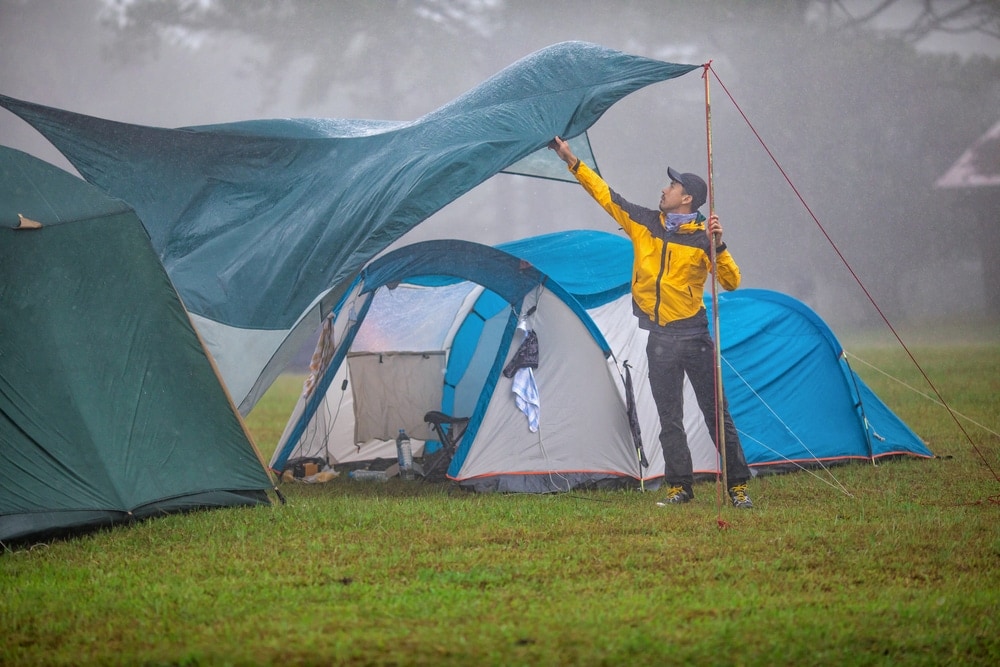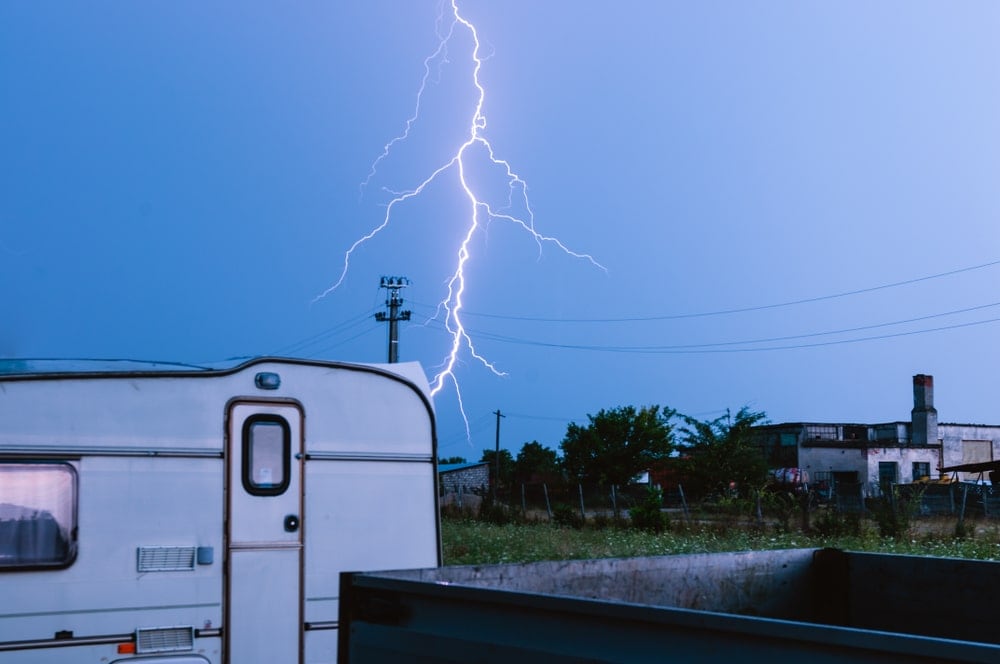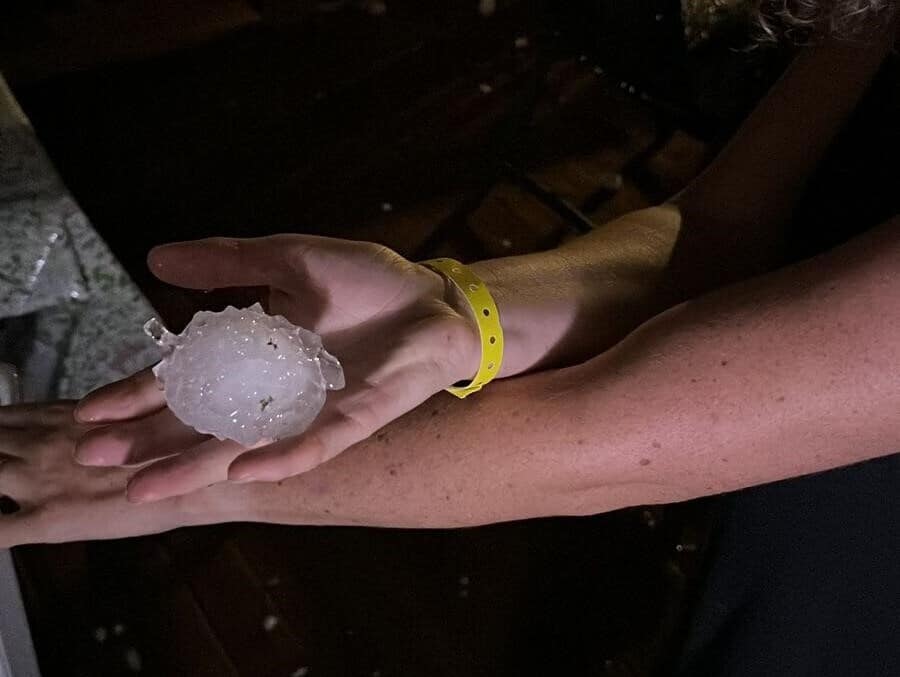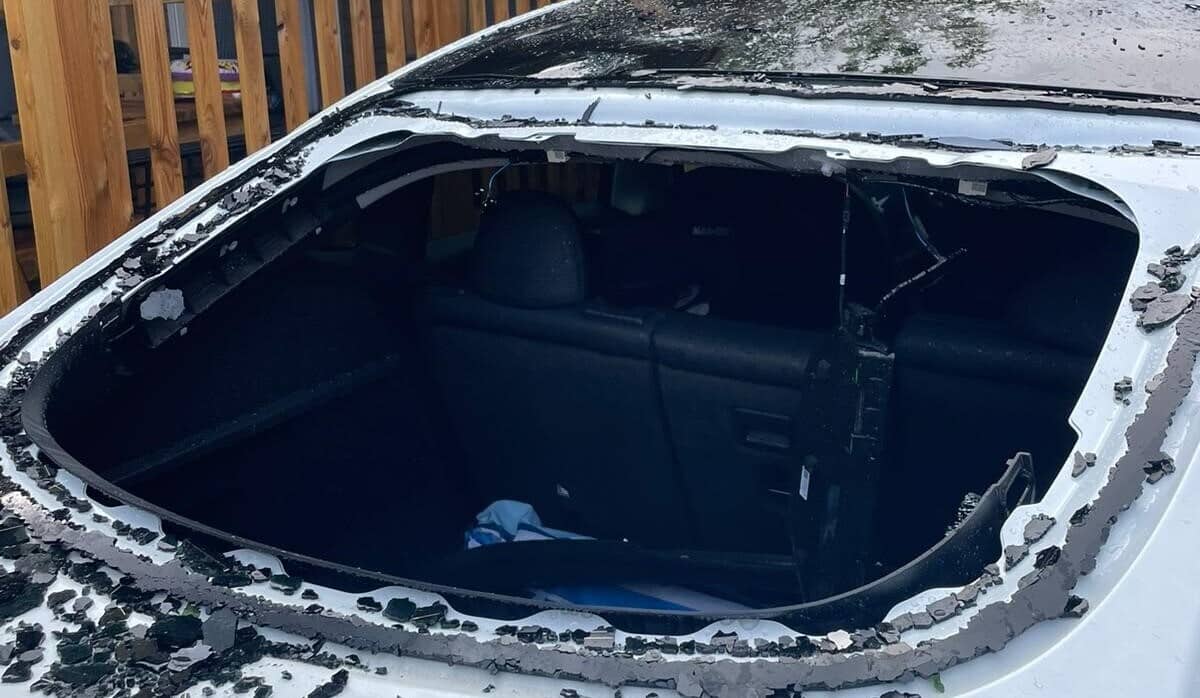
What to do in a storm while camping?
15 August, 2023
Although a thunderstorm is a beautiful natural phenomenon, it can also be dangerous, especially if you don’t know how to deal with it. What do you do when there is a thunderstorm at the campsite? How safe are you in a tent, trailer tent, motorhome or caravan? And what should you do with heavy hailstorms? Read on to learn all you need to know.
A thunderstorm can occur suddenly
Perhaps you have experienced it: you are enjoying a sunny day in Italy or France, but in the space of just a few minutes, the weather turns. And there you are, in your tent or caravan, in the middle of a thunderstorm. That happened this past week in northern Italy, where campsite guests suffered massive damage due to severe weather.
The cause? A thunderstorm can occur suddenly when warm air rises quickly and ‘rubs’ past cold air that drops rapidly. This friction causes clouds to be electrically charged. This electricity is discharged towards the earth or other clouds in the form of lightning. Rapidly dropping cold air during a thunderstorm can sometimes cause the temperature to drop 10 to 15 degrees.

The weather can change quickly, so keep a close eye on it.
When should you take shelter?
What is difficult about a thunderstorm at the campsite is knowing when you should take cover. A good rule of thumb is: when there is less than ten seconds between lightning and thunder, it’s time to find a safe place.
Because light travels faster than sound, you see lightning before you hear the thunder. Sound travels 1000 metres in three seconds. If there are ten seconds between the flash and the bang, the thunderstorm is about 3 kilometres away. You still have enough time to find a safe place at the campsite.
How safe are you at the campsite during a thunderstorm?
How safe you are at the campsite during a thunderstorm depends entirely on the type of accommodation you have. Here are the most common options.
Tent and trailer tent: find a safe place
A tent or trailer tent doesn’t offer any safety from a thunderstorm. If anything, the steel or aluminium poles will attract a lightning strike. You should never stay in the tent or trailer tent during a thunderstorm. If you are camping in a tent or trailer tent, the best option is to find shelter in a building – the recreational building, for example, or the restaurant or the toilet block. Or in the motorhome or caravan of other campsite guests.
Caravans and motorhomes: (usually) suitable as shelter
Caravans and motorhomes are a different story. When the structure of the caravan or motorhome is constructed mostly of steel or aluminium, you are relatively safe. The caravan or motorhome will conduct the lightning and let it disappear into the ground. However, if the caravan or motorhome is mostly polyester, then you should find a safe haven.

Make sure that you find safe shelter during a thunderstorm.
Good preparation is half the work
A thunderstorm can make a camping trip tense, but with proper preparation you will know exactly what you must do. Some useful tips:
- Make a plan: discuss beforehand what you will do if there is a thunderstorm. This is how you prevent panic, and everyone will know what they are expected to do.
- Keep an eye on the weather: keep an eye on the weather around you and start counting the distance as soon as you first see lightning. Then you know whether the thunderstorm is coming towards you or leaving.
- Taking shelter: when the thunderstorm is less than 3 kilometres away, it is best to find a safe shelter. The best places for this are your motorhome or caravan if it is constructed mainly out of steel or aluminium, or a building like the reception, the restaurant or the toilet block. If there is a thunderstorm, you can also take shelter in the car. This is very sensible if there is hail.
- Park the car near the tent: are you camping with a tent? Make sure the car is nearby. Then you can shelter in the car if a thunderstorm is expected.
- Fold in (dish) antennas: the less sticking out from your caravan or motorhome, the smaller the chance of being struck. Note: do not do this during the thunderstorm.
Lightning strike in the car: the Faraday cage effect
The car is still one of the safest places to be during a thunderstorm. This is because of something known as the ‘Faraday cage effect’. The metal bodywork of the car functions as a conductor, conducting the electricity from the lightning around the car and leading it down into the ground. The electricity thus disappears through the car into the ground and does not strike the people sitting in it.
It is important to remember that during a thunderstorm you must stay in the car with the windows and doors closed. Avoid touching metal parts! Although a lightning strike to your car can damage the electronics, the chance of personal injuries are minimal thanks to this protecting effect.
What should you do if it hails?
Hail can be unexpected and destructive on a camping trip. The sudden and violent precipitation of ice balls can damage your car, caravan or motorhome and other camping equipment. It can even be dangerous if you get caught in it unprotected.
If hail is predicted, it is important to prepare your pitch for it as best possible. Make sure that all loose items, like chairs, tables and grills, are safely stored or tied down. Hail is often combined with a severe storm, which means that loose objects could be blown away or damaged.
If you have an awning or canopy, make sure it is properly tensioned and that there are no spots where water and hail can collect. A heavy buildup of hail can damage the structure of your tent or canopy.
If you are camping in a tent, it is best to find sturdier shelter, preferably a building at the campsite. A tent offers little protection against the hard impact of hail stones. A car is an option with ‘normal’ hail but be aware that extreme hail can even smash car windows. There are many stories about hail storms with hail stones as big as a tennis ball. In this situation, a car is not safe either. A tip for protecting the roof of your car somewhat: tie a sturdy inflatable bed to the roof.

Hail stones can be as big as tennis balls.
Hail damage
Wondering what to do with hail damage? If your car, caravan or motorhome is damaged after a hailstorm, it is important to first of all determine whether you can still drive home safely. Damage to the roof or other parts of the bodywork can be repaired at home, but a broken windscreen must first be repaired.If that is the case, always contact the emergency centre first. They can help you find local body repair workshops.
Take photos of the damage as soon at the hailstorm has passed as evidence. Bear in mind that damage caused by storm or hail is not covered with third-party insurance, but it is covered with WA Plus limited comprehensive insurance.

Hail can cause serious damage to cars and recreational vehicles.
High winds and wind gusts: what to do?
At the campsite, you may also have to deal with high winds and sometimes wind gusts. How do you keep your camping things safe in these situations? With high winds, it is important to anchor your recreational vehicle firmly. Make sure that tents, trailer tents, motorhomes and caravans are set up firmly and secured properly with pegs, guy ropes or weights. Check regularly whether everything is still fastened securely, especially if the wind force increases.
It is also recommended that canopies, awnings and other loose parts be rolled up and stored. This prevents them from being damaged or even blown away by strong gusts of wind. Be alert for overhanging branches or other objects in the area that could pose a hazard in strong winds.
With extreme winds, it is wise to remain in your recreational vehicle as much as possible. Make sure that all windows, doors and ventilation openings are closed to prevent wind or dust from entering. If you are camping in a tent, consider moving temporarily to a building at the campsite or to the motorhome or caravan of a fellow campsite visitor until the wind dies down.
Leave a review
Do you have some good tips for surviving a thunderstorm at the campsite? Be sure to share them below with your fellow campsite visitors!










Latest comments